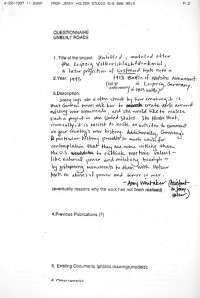Title of the project: Untitled, modeled after the Leipzig Völkerschlachtdenkmal, a lazer projection of Lustmord texts onto a 1913 Battle of nations Monument. (100yr in Leipzig, Germany anniversary of 1813 battle)
Description: Jenny says she often struck by how amazing it is that German [illegible] ask her to create work around exisiting war memorials, and she would like to realize such a project in the United States. She thinks that, ironically, it is easiest to invite an outsider to comment on your country's war history. Additionally, Germany's particular history provides so much cause of contemplation that they are more willing than the U.S. to rethink wartime vaues - like national power and military triumph - by juxtaposing monuments to them with Hotzer texts on abuses of power and terror in way - Amy Whitaker (Assistant to Jenny Holzer)
Leipzig: Kriegszustant
The Leipzig Völkerschlachtdenkmal was commissioned by the German Patriotic League in 1913 as a memorial to the 1813 Battle of Nations. The stucture itself -- a tuncated Pyramid, approimately 100 meters tall and adorned with colossal statues of men in armor -- as intened to symbolize such wartime values as national power, courage, perseverance, and military triump. Since 1913, the monument and its values have appealed to political parties as disparate as monarchists, Nazis, and communists.
In 1995, Klaus Werner and Föderkreis der Leipziger Galerie Für Zeitgenössich Kunst e.V. invited Holzer to create an installation there. For Kriegszustand, meaning "state of war", Holzer projected a laser onto the monument and its reflecting pool to present subjects equally present, through taboo, in times of war: fear, abuse of power, rape, torture, loss of human dignity, terror, and violence. The texts were German translations of Lustmord and other series, and included such statements as "The color of her where she is inside out is enough to make me kill her."
Title of the project: Untitled, modeled after the Leipzig Völkerschlachtdenkmal, a lazer projection of Lustmord texts onto a 1913 Battle of nations Monument. (100yr in Leipzig, Germany anniversary of 1813 battle)
Description: Jenny says she often struck by how amazing it is that German [illegible] ask her to create work around exisiting war memorials, and she would like to realize such a project in the United States. She thinks that, ironically, it is easiest to invite an outsider to comment on your country's war history. Additionally, Germany's particular history provides so much cause of contemplation that they are more willing than the U.S. to rethink wartime vaues - like national power and military triumph - by juxtaposing monuments to them with Hotzer texts on abuses of power and terror in way - Amy Whitaker (Assistant to Jenny Holzer)
Leipzig: Kriegszustant
The Leipzig Völkerschlachtdenkmal was commissioned by the German Patriotic League in 1913 as a memorial to the 1813 Battle of Nations. The stucture itself -- a tuncated Pyramid, approimately 100 meters tall and adorned with colossal statues of men in armor -- as intened to symbolize such wartime values as national power, courage, perseverance, and military triump. Since 1913, the monument and its values have appealed to political parties as disparate as monarchists, Nazis, and communists.
In 1995, Klaus Werner and Föderkreis der Leipziger Galerie Für Zeitgenössich Kunst e.V. invited Holzer to create an installation there. For Kriegszustand, meaning "state of war", Holzer projected a laser onto the monument and its reflecting pool to present subjects equally present, through taboo, in times of war: fear, abuse of power, rape, torture, loss of human dignity, terror, and violence. The texts were German translations of Lustmord and other series, and included such statements as "The color of her where she is inside out is enough to make me kill her."

